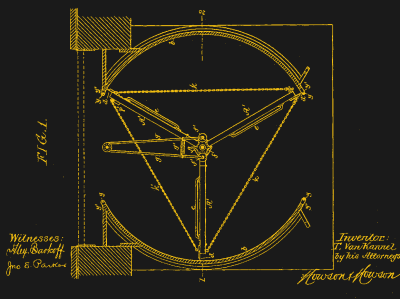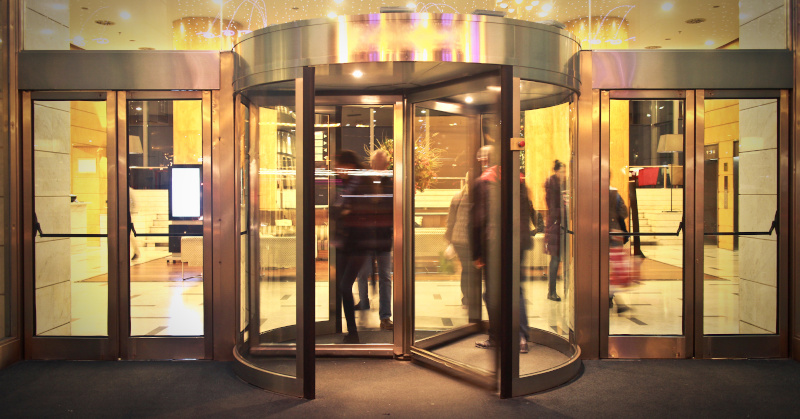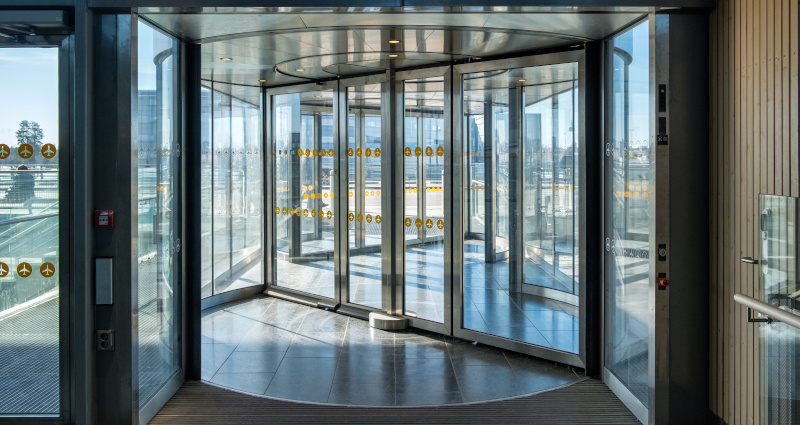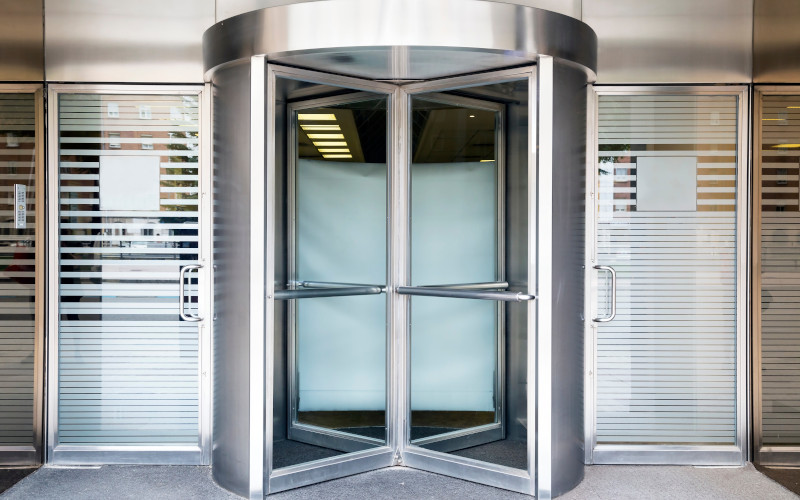While most of us have been content with swing and sliding doors for the vast majority of our needs around the home, the revolving door remains popular in a wide variety of contexts.
It’s a confounding contraption that always feels ready to snatch and ensnare the unwary user. However, these doors do have certain benefits that have allowed them to retain popularity in many public buildings around the world. Let’s dive in to why below.
You Spin Me Right Round

The revolving door dates back to the late 19th century, with two main patent filings occurring around that time. One H. Bockhacker in Germany filed a patent for a rotating cylindrical door in 1881. Meanwhile, the more well-known Theophilus Van Kannel was granted a patent in 1888 for a three-partition revolving door with all the major features we’re familiar with today.
Both of these inventors were keenly aware of the benefits of such a design. Their rotating doors were intended to allow entry and egress from a building without excessive exchange of air. Swing and sliding doors enable wind and rain to easily enter a building unless used in a dual-stage airlock design. In comparison, a rotating door that is sealed at the edges prevents this almost entirely. Only a small pocket of air is exchanged as each segment of the door rotates. Even better, a properly-designed rotating door won’t get blown open by the wind, and allows people to enter and exit a building at the same time. These benefits led to the adoption of rotating doors in many public buildings.
In fact, due to the lower amount of air exchange, the revolving door has become a key feature in many skyscrapers. These taller buildings are subject to what is referred to as the “chimney effect.” As the building’s HVAC system heats the air inside, this warm air rises as its buoyancy increases. This creates a pressure differential with a lower pressure at the base of the building. When a swing door is opened at ground level, this causes an in-rush of air. This then forces heated air out the top of the building in turn. This breeze is frustrating for occupants and bad for efficiency, as the fresh air must then be heated again, using more energy. The same effect happens in the warmer months, too, in reverse, as cooler air sinks through the building in the opposite direction.

The naturally-sealing design of a revolving door prevents this issue. While the door does not seal as well as a regular closed swing door, it exchanges far less air as it works compared to a swing door being open and closed repeatedly. The effect is noticeable even in smaller buildings. Larger buildings that are more subject to the chimney effect, with greater pressure differentials, will notice significantly greater benefit.
A simple study run by MIT in 2006 found that the benefits from revolving doors could be profound. Estimates were that solely using revolving doors in one building would save 74% of its current annual energy consumption on heating, cutting 15 tons of CO2 output.

It does highlight one of the pitfalls of the revolving door, however. In order to gain the benefits, the revolving door must be used in preference to swinging types. Even in buildings with revolving door entrances, many building codes mandate that swinging doors also be present. This is often wise practice, as revolving doors can be a liability in an emergency, prone to being jammed or overwhelmed by sudden rushes for the exits. However, if people regularly use the swing doors in preference to the revolving door, it’s not saving any energy at all.
It’s a simple fact that revolving doors often present a frustration to busy people. There’s a reason they don’t often appear in action films — after all, there’s pretty much no way to get through one in a hurry. Manually push-operated types can allow someone to push through quickly, but the rate must be limited mechanically to avoid injuring other people that may also be transiting the door at the same time. Alternatively, automatic doors can turn at a constant rate, but they must often be relatively slow in order to remain accessible to those who aren’t as mobile and quick as others. Careful provision must also be made for proper access by wheelchair users and those using other mobility aids.
Overall, revolving doors have an important role to play in our buildings. They may be slow and frustrating, particularly when the automatic ones randomly stop (looking at you, IKEA), but they can save us huge amounts on our energy bills. That’s good for the climate too, at a time when we need every last bit of efficiency we can get!
















Crowd control, HACK the planet.
The most infuriating thing about manual revolving doors in the spin-rate limiters almost always have hysteresis: if you ever push the door sliiiiightly too fast, the brake will engage, but not disengage until the door has come to a near complete stop. If it disengaged after the door dropped below the max spin rate (and better yet, had a pre-brake warning indicator when you were approaching the max spin rate set) it would be much less annoying.
Ken Clack proved you can spin it fast enough so it looks like a blur and could get changed into Superman (So much for action films not having revolving doors).
The single biggest issue I have experienced is the problem of replacing the curved glass that makes up the cylinder. Glass changes size when tempered. With flat glass, there is lots of experience on what allowance to make. Getting a curved panel made that will be right after tempering is still an art (lot of guess work) that requires guesses and estimates by an experienced person. A building in which I worked had one broken. Our glass contractor had quite a few people in, including a rep from a tempering company, before ordering the curved panel. We had to leave the swing doors on two way access during that time, as one rotating door could not handle the traffic. (Fire regs the swing doors had to open to exit, and we were not allowed mag locks on them)
Wind can make them fun, too!
https://www.youtube.com/shorts/Nwz0OwHsNLU
Could the required swing doors be in airlock configuration? It seems most of the largest buildings which benefit the most from minimizing air exchange also generally have fairly large lobbies on the ground floor which could handle the extra space of a hallway style airlock.
Here in Finland, most public buildings use an “airlock configuration.” It’s been several decades since I’ve seen actual revolving door anywhere.
How does it work? Are they wired not to open at the same time?
Car doors could sure use that for windy days!
B^)
In the desert, we try to take advantage of that effect when possible to blow the 150F air out of the car before climbing in.
No. They just open when people walk up to the door, or they’re completely manual. There’s no high-rise buildings in Finland, so the chimney effect is simply not a consideration.
Buildings with automated sliding doors often use column air blowers or drop-down air curtains to keep the warm interior air from rushing out every time the door opens. You always get a blast of air to your face when you walk through the inner door.
That said, there’s revolving doors in the nearby supermarket here.
The local sports “dome” (an inflatable self supporting structure) uses a revolving door to keep the interior air pressure high enough to aid support of the dome.
As one who uses a walking aid (a cane) and moves rather slowly, revolving doors are a complete no-go for me.
Which is kinda sad, because I used to really enjoy them when I was younger and healthier.
They have revolving doors at one of the hospitals here. Very big, I assume to accomodate wheelchairs. I think they turn automatically, I don’t remember pushing them.
The doors for the subway system are notorious. They take a lot of effort to push open. Though some now have a button to press to open by power.
Lot of hospitals use the automated airlock design.
My local hospital has a somewhat small and rapid turning revolving door, but it has automatic standard style doors on either side of it. All three lead into a large airlock area with a set of sliding doors leading into the hospital. I’m pretty sure that a wheelchair wouldn’t fit through the revolving door there, which begs the question of why did they bother with it in the first place, except perhaps that they wanted to use as many different types of doors as possible in a single entryway.
You know what else saves energy? Adjusting the thermostat.
It depends on who is doing the adjustment.
B^)
You know what helps even more after you’ve adjusted the thermostat?
Revolving doors.
Oath!
Boon Edam had (they no longer offer it) a revolving door that allowed two streams of people to cross, but not mix (think airport incoming and outgoing passengers) by using outer doors and inner compartiment doors that moved independently from each other.
While I don’t understand how that would work, why would that be needed at an airport? Once outside, people can generally go wherever, so the door would be outside of any security or customs zone anyway?
” In comparison, a rotating door that is sealed at the edges prevents this almost entirely. ”
Wankel doors.
Wankel People Pump.
B^)
I award you One Internet Merit point!
I did contemplate the Horsepower Dorito during the writing of this article, yes!
Not sure I would agree they are annoying. I hadn’t seen one for years till the other week and it was quite refreshing. Especially as I didn’t have to navigate the oncoming foot traffic. I didn’t even think about the airlock aspect of them! I would welcome seeing more of them in use, particularly at the supermarket
I don’t see them working too well with shopping carts.
Annoying? I love revolving doors!
Revolving doors take more space than any other door, and have a tendency to eat handbags, long hair, and loose-fitting jackets, dresses, and skirts. You also have to match the speed of your movements with other people attempting to use the door at the same time, which could be deadly in the event that you need to suddenly evacuate the building.
There are lots of reasons why you would want to prop a door wide open, and chief among those is safety.
I love how people condemn a thing for “not being as good as the old thing” in a very rare event, even when there is already a solution (as mentioned in the article: middle panels opening as emergency doors) in case the rare event happens.
Which is why ones I’ve seen have the doors on some kind of hinges at the centre, so they can be pushed out of the way / collapsed to convert the rotating door to a big open hole to evacuate through. (Also as a fail safe if power goes)
I was eaten by a revolving door once. Wind against the building created high pressure outside and relatively lower pressure inside, so at the point where the airflow changed the panel behind me broke loose and pinned me to the panel in front of me. A safety mechanism locked the door when the panel came loose. I assume the panels are designed to break away safely under enough pressure rather than sustain damage.
Revolving doors really need to be compared to regular doors In an airlock configuration. IMO the footprint of the two is pretty similar, yet the airlock is mechanically simpler and doesn’t hold you up when you’re in a hurry. Id be curious to hear why anyone would choose a revolving door over that.
My guess would be throughput, an airlock configuration either stops being an airlock when sufficient people pass through it as both doors are open at the same time, or it becomes a bottleneck as the doors are waiting for the other set to close. Annoying as revolving doors are, they work quite well when properly scaled to the expected flow of traffic, while keeping the airflow minimal.
Does not hold you up? If you use it as an airlock the first one needs to be completely closed before the second one starts to open. You need a very long airlock or walk very slowly if that does not hold you up.
Revolving doors in Brussels:
https://www.ucl.ac.uk/european-institute/news/2019/jul/revolving-doors-or-sliding-doors-brussels
Not just Brussels! See below…
My feeling is that revolving doors “save” energy in the same way that sneeze guards “prevent” disease at buffets. Dave Barry once opined that all sneeze guards do is cause people to spit into the creamy ranch dressing. In the same way, every time I see a revolving door, I look for and deliberately use a “normal” door instead.
Wouldn’t do the former because that’s just disgusting and terrible… but the latter, guilty as charged. I hate automated revolving doors with a passion, they are just excruciatingly slow and when the safety mechanism is triggered (often by even looking funny at those bumpers) they stop fully.
One of the most common places to find the double airlock door in the USA is at Wendy’s restaurants. Could be all of them use double doors. K-Mart was a company that often used two rows of power sliding doors to slow down heat gain/loss.
In the UK, revolving doors have a second use – to aid the re-employment of government officials in private companies, and vice-versa, usually accompanied by golden handshakes, and the unethical profiteering from knowledge gained in the other sector.
That IKEA doors are not randomly stopping, they have proximity sensor for stopping when someone is too close to them.